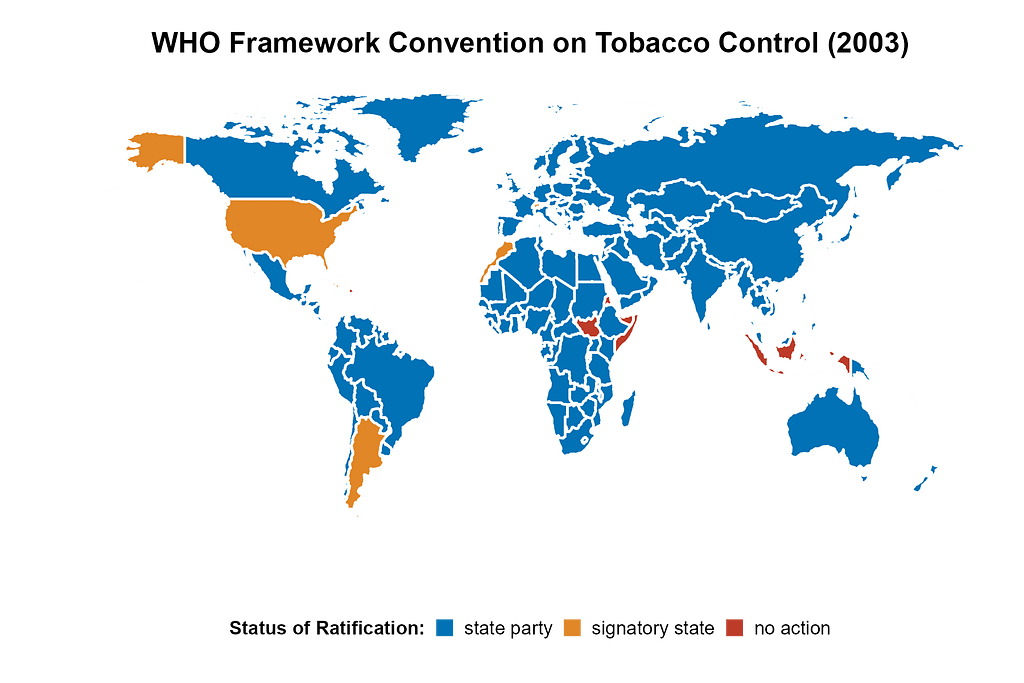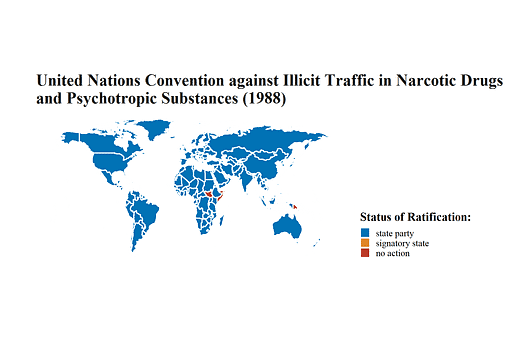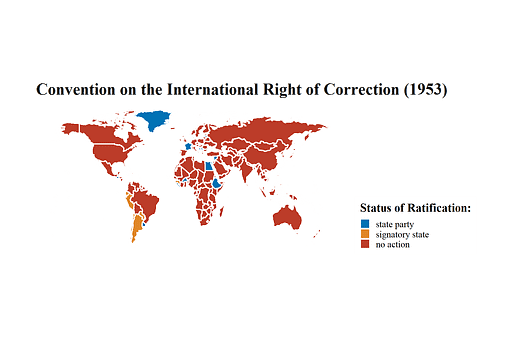LUIZA WADGE & PATRICK WALSH
In this post, we analyze the status of ratification for the WHO Framework Convention on Tobacco Control. The treaty was adopted on May 21, 2003, as the first-ever treaty negotiated under the authority of the World Health Organization. It entered into force on February 27, 2005, after 40 states ratified the treaty.
The framework emerged in response to the growing tobacco crisis throughout the world, urging world governments to recognize it as an epidemic requiring intergovernmental cooperation. Central to this treaty is the recognition of public health rights, mandating state parties to devise national policies reinforcing tobacco control measures. Importantly, it emphasizes the imperative to counteract any unwarranted influence exerted by the tobacco industry on these policies.
To analyze this treaty’s ratification status, we used the ggplot2 package for R to create a choropleth map. The choropleth map categorizes states into three groups: “state party,” “no action,” or “signatory state,” based on information sourced from the UN Treaty Collection’s website. “State party” reflects states that have ratified or taken other action beyond signing the treaty, while “signatory state” refers to states that have signed but not yet ratified the treaty. “No action” refers to states that have not ratified or signed the treaty.

As the map illustrates, despite large-scale lobbying efforts led by the tobacco industry against the ratification of this convention, more than 170 countries have ratified this agreement. It is worth noting, that the United States, while not ratifying the framework, has implemented many of its main provisions with the adoption of the Family Smoking Prevention and Control Act, a federal law passed by the U.S. Congress in 2009.
Not all state parties have responded equally to the convention’s aims, expectations, and obligations. For instance, despite Zimbabwe’s ratification of the framework in December 2014, the country has been hesitant to implement new regulations governing its tobacco industry (Lown 2016). Notably, “tobacco is Zimbabwe’s second-largest source of foreign currency” after gold. While Zimbabwe, alongside other nations, has fallen short of meeting its international commitments, many scholars suggest that fellow state parties can apply pressure on Zimbabwe to enforce more robust tobacco controls or assist in exploring alternative options for its tobacco industry.
To sum up, the WHO FCTC has garnered significant participation from state parties. However, broad engagement does not guarantee policy success. Many nations have not taken substantial steps domestically to combat the tobacco epidemic. Furthermore, illicit trade remains a challenge, especially in Africa and Latin America, where some economies heavily rely on tobacco production due to limited resources. While the FCTC represented a strong start for the WHO’s global public health care efforts, there’s a pressing need for continued action.
Want to learn more about this legal instrument?
Data on this convention’s ratification status is available on the World Politics Data Lab’s GitHub page. The most recent dataset was uploaded to the repository on October 1, 2023.
For more information on the convention’s history and its current application, please refer to the following academic writings:
Roemer, R., Taylor, A. and Lariviere, J. (2005). “Origins of the WHO framework convention on tobacco control,” American Journal of Public Health 95(6):.936-938.
Taylor, A.L. and Bettcher, D.W. (2000). “WHO Framework Convention on Tobacco Control: A global ‘‘Good’’ for public health,” Bulletin of the World Health Organization, 78(7): 920-929.
About the authors:
Luiza Wadge is a junior, majoring in International Relations with a minor in Sociology at Drew University.
Patrick Walsh is a junior, majoring in International Relations and Women’s and Gender Studies at Drew University.
Editor’s note: This post is part of a long-term project. Students enrolled in Drew University’s Semester on the United Nations, Principles in International Law, and International Human Rights have been and will be collecting data on the ratification status of treaties deposited in the United Nations Treaty Collection. For more information on this project and its learning goals, click here.


